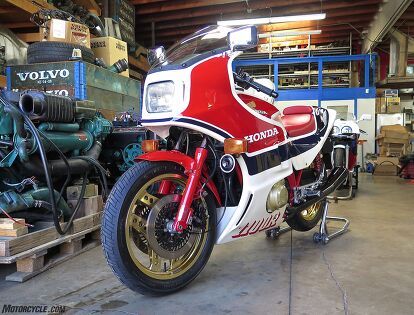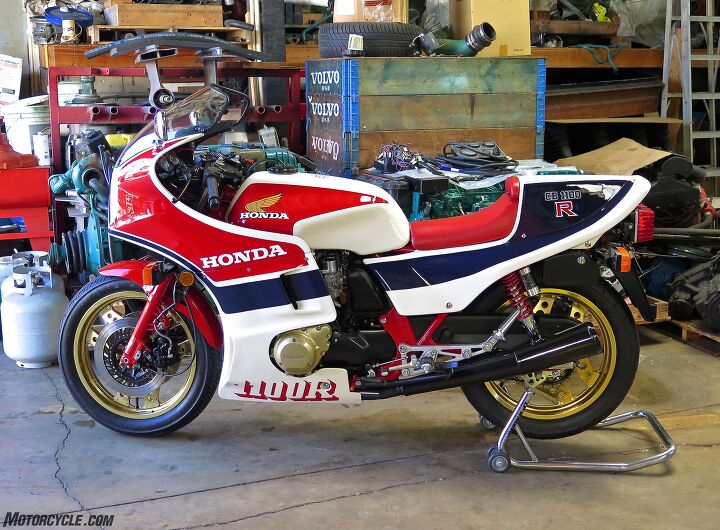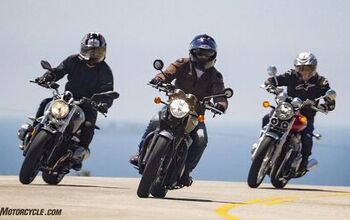Archive: 1982 Honda CB1100R
Honda's first homologation special was the beastliest thing you could buy in 1982
Here’s another rare old beast that never made it to America, not officially anyway. Produced from 1981 to ’83, the CB1100R was Honda’s first “homologation” special, meaning a bike that had to be made available for sale to the public to qualify for racing. According to various sources, 1050 were produced in 1981 (CB1100RB), followed by 1500 in 1982 (RC), and a final 1500 more in ’83 (RD). The bike pictured above, owned by our friend and top geezer Grant Hellinger, is CB1100RC number 1500 – the last one to roll off the line in ’82.
Squeezed in amongst Grant’s RC30s and 45s and Dunstall Z1s and whathaveyou, the old CB is bigger enough than the rest of them that it has more in common with the boats it’s now Grant’s business to power up. Before getting into that business, he supported himself by importing luxury cars from the U.S. back to his native England, and did well enough at it to return some of his profits in the form of collectible motorcycles. The man knows his nuts and bolts. I had to harangue him for a year or two before he’d dig the CB out for my camera, and that’s only after I threatened to publish nude photos of it I’d shot when I spied her on the lift at MotoGP Werks a few days earlier. (Guess what? I’m publishing the nude pics anyway!)
Not that we want to piss Grant off. He’s a really big guy, at least 6.5 feet tall, and he and the old CB both remind us of a time before everything shrunk, before the riders all became jockey-sized exercisers instead of larger-than-life figures who led the sort of cavalier lifestyles a non-aspiring young person of the ’80s could get behind. Honda said the CB weighed 518 pounds dry, and had a 59-inch wheelbase between the two contact patches of its 18-inch bias-ply tires. It’s big enough for a big guy to ride comfortably.
Honda built the thing to take part in Australia’s Castrol Six-Hour, an annual event that rivaled the Suzuka 8-Hour in importance from 1970 to ’87. The CB did its job, winning in 1980 and ’82 under Wayne Gardner (and co-riders Andrew Johnson and Wayne Clarke, respectively). It also came along at a good time to compete in a new form of streetbike racing in the UK and elsewhere; the Avon/Shell/Motorcycle News-sponsored series in England was getting off the ground at about the same time production-based Superbike was finding its legs in the U.S.
The bike’s DOHC engine was based on the one in the CB900F. Keeping with its 69mm stroke and increasing bore from 64.5 to 70.0mm bumped displacement 161cc, to 1062. Lightened and higher-spec internals, including “semi-forged” pistons and bumpier, longer-duration cams, along with an increase in compression to 10:1, bumped horsepower from a claimed 95 at 9000 rpm to 115, and torque from 57 lb-ft to 72.5. A bank of 33mm Keihin CV carburetors replaced the 32mm ones. Taller final-drive gearing than the 900F’s gave the R a theoretical top speed of 155 mph. Today, 115 hp doesn’t seem like a lot. At the time, the R was a fire-breather and the most powerful beast you could buy.
Due to its being Honda’s first “racebike” available to the public, a lot more work than usual went into some really beautiful detailing, right down to the shiny chrome mirrors. The 6.9-gallon gas tank is aluminum, the really delicious paint is laid down on top of the same sort of carbon-fiber fairing Honda used on its factory race bikes, long before we’d heard of carbon fiber. Painting the fork legs to match the red frame is a nice touch (a thing Honda carried forward which forced me to buy an ’86 VF500F with my student loan money), and the red steel-tube frame sort of makes you pine for the old days. It all added up to a bike that sold for about a 50% premium over other sporting liter-bikes of the era, around $9,000 U.S.
Everything about this bike marks the end of an era and the beginning of a new one. Honda made its name with air-cooled inline four-cylinders in steel-tube frames, and this CB is the highwater mark: The very next year, 1983, saw the first liquid-cooled V-four Honda appear in the new Interceptor’s perimeter frame. In 1987, Michelin rolled out its first radial tire… by 1988 Honda’s next homologation special was here, the RC30, a bike that made the 1100R look old, fat and outdated far beyond its years. The CB1100R became a relic in its own time, a classic before its first set of tires was worn out. At the time it was yesterday’s newspaper. Today, it looks more beautiful than ever, and transports us right back to that cliched “simpler time” before cheap thrills like bike racing became quite so desperately corporate, before mass production became quite so massive. I still feel a little Soichiro Honda peeking out of this one. You?
More by John Burns






















































Comments
Join the conversation
They have one of these at Barber Motorsports Museum...it looks showroom new and completely awesome.
I have a new perception of my '13 CB1100 now. I knew it was based on an earlier CB1100, but I didn't know how significant the original was. I'm also impressed with how close the two designs are, which is especially evident in the "naked" photos. The frame, engine, footpeg carriers, and exhaust are all very similar. They should have matched the power outputs as well; the '13 is down about 15-20 HP from the original.